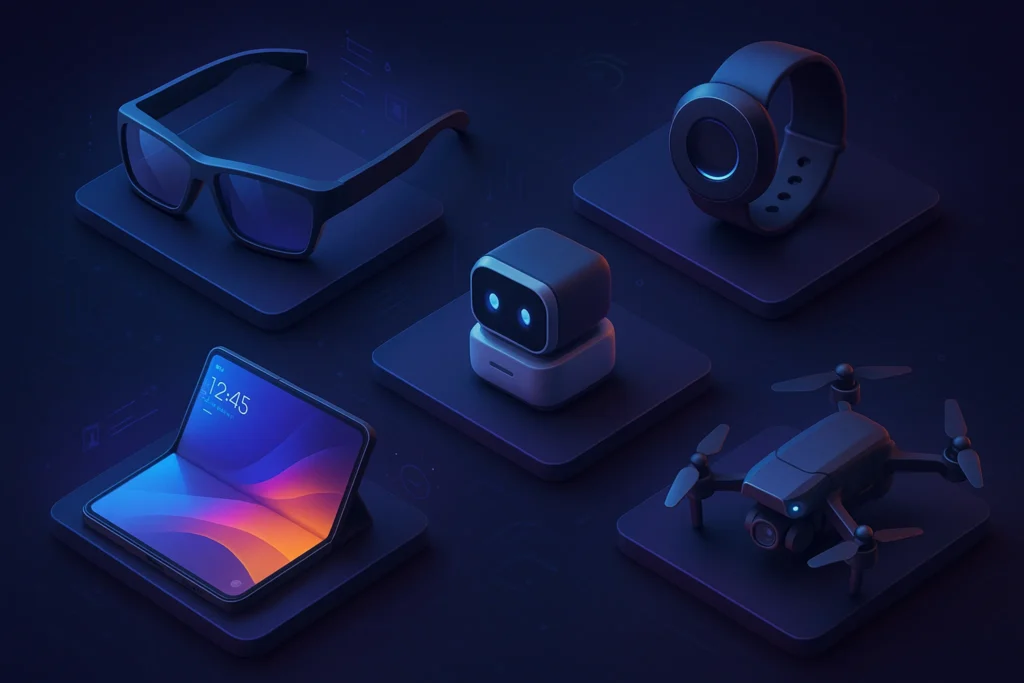-This post may contain affiliate links. If you click on one and make a purchase, I may earn a small commission at no extra cost to you.-
🧠 Introduction
Imagine living in a world where movie-grade sci-fi tech is part of everyday life — and it’s not far off. In 2025, gadgets once relegated to blockbuster sets or the pages of futuristic novels are now out in the wild, primed to enhance our lives. From smart glasses that overlay real-time info on the world, to mood-readers sculpting our home environments, the future is already here.
This roundup covers eight cutting-edge categories, each brimming with real products you can buy today. We’ll explore what they are, why they’re game‑changers, and how they bring the magic of tomorrow into your routine. NerdChips.com readers, get ready — it’s time to geek out on what the next level of daily tech looks like!
What once seemed cinematic fantasy is now in your hands. In 2025, gadgets like AI-powered smart glasses, home companion robots, foldable-screen phones, and virtual-reality wearables are no longer prototypes—they’re real products you can order today.
This post dives deep into standout gadgets, explaining what they do, why they matter, and how they improve your everyday life. Whether you’re a tech enthusiast, content creator, or curious explorer, these devices take the edge off daily routines and bring tomorrow, today.
1. AR Smart Glasses – Xiaomi & Meta Ray-Ban
Gadgets like Xiaomi AI Glasses and Ray-Ban Meta Smart Glasses bring powerful head-up displays, real-time translation, and AI-enhanced vision to everyday eyewear. Xiaomi’s sleek frames use Snapdragon AR1 chips to overlay text translations, object recognition, even QR-based payments—lasting ~8.6 hours per charge
Why it’s groundbreaking: No longer niche—these glasses combine style and function for real-world use: navigation while walking, voice-controlled calls, or overlaying translations in foreign bookstores. They’re stylish enough to wear publicly—and silently productive.
📎 Xiaomi AI Glasses
-
What they are: Lightweight AI-enhanced AR glasses (~40 g) packed with a Snapdragon AR1 chip, 4 GB RAM, 32 GB storage, Wi‑Fi 6 and Bluetooth 5.4
-
Why they’re innovative: Featuring electrochromic lenses that auto-tone in just 0.2 s, a 12 MP Sony IMX681 camera capable of 2K recording, and a full suite of AI features—real-time translation, object recognition, calorie counting, QR payments via Alipay. Bone‑conduction audio and ANC mics boost clarity, while a claimed 8.6 h runtime outpaces competitors
-
Enhancements: Ideal for on-the-go tasks—translate on the fly, scan items, handle payments without digging for your phone, and even capture life hands-free. Backed by an AI assistant (XiaoAI) tailored to integrate the device into smart-home ecosystems.
🎯 Ray‑Ban Meta Smart Glasses
-
What they are: Stylish frames co-developed by EssilorLuxottica and Meta, with dual cameras, open-ear speakers, integrated microphones, touch controls, and a Snapdragon AR1 Gen1 chip.
-
Why they’re innovative: Upgraded to 12 MP cameras, a 5-mic array, and 32 GB onboard storage—good for ~500 photos or ~100 videos. With Meta AI and direct streaming to social platforms, these glasses blend tech with everyday eyewear.
-
Enhancements: Designed for discreet content capture, voice interaction, and sharing on-the-move. They strike a fashion‑tech balance, though without full AR overlays—perfect for casual users who want media capture with style.
What it is:
Modern heads-up display eyewear capable of live translation, notifications, and basic AI-driven features.
Why it matters:
Instead of checking your phone when traveling or working, the information is discreetly overlayed—translations, schedules, texts—all without looking away.
Real Use Case:
Walking through Tokyo’s subway? Over-the-ear translations guide you in real time. As you’re reading a physical book, reminders and highlights pop up in your vision.
Pros:
-
Seamless display integration
-
Hands-free translations
-
Fashion-friendly frames
Cons:
-
Limited battery (6–10 hrs)
-
Modest AR app library
Grab latest Xiaomi AI Glasses →
2. Apple Vision Pro
The Apple Vision Pro headset merges the digital and physical worlds with ultra-high resolution, eye-tracking, hand gestures, and floating app windows. Think watching movies on a massive virtual screen or placing virtual tabs in your workspace with simple swipes.
Why it shines: Apple’s ecosystem polish, combined with spatial audio and seamless control, makes it arguably the most user-friendly mixed-reality device yet. Ideal for immersive work, 3D apps, or virtual meetings.
-
What it is: Apple’s flagship mixed reality spatial computer, launched in early 2024 and now available across major markets. Featuring dual 3,660×3,200 OLED micro-displays (one per eye) at up to 100 Hz (~10 megapixels per eye), eye- and hand-tracking, powered by M2 + R1 processors, and running visionOS. Apple’s spatial-computing headset featuring ultra-high resolution, eye tracking, and gesture control—anchoring virtual objects in your real environment.
-
Why it’s innovative: It delivers unmatched visual fidelity, seamless passthrough AR, and intuitive gesture input. Features like “EyeSight” outward displays promote social awareness, and unique tools allow creation of spatial photos/videos .
-
Enhancements: Users can immerse in VR, overlay apps on their workspace, watch movies on massive virtual screens, and relive memories in spatial video. While reviewers praise the hardware and experience, usability nuances like eye-tracking consistency and limited battery (~2–2.5 h) remain unlocked challenges.
Why it matters:
It transcends screens—watch movies on a massive virtual display, multitask in virtual desktops, and enjoy immersive workspaces without disrupting your physical world.
Real Use Case:
Edit photos in a virtual darkroom next to your real desk; host FaceTime sessions with floating windows; or render a design project in 3D space.
Pros:
-
Immersive mixed reality
-
Apple ecosystem compatibility
-
Excellent visual fidelity
Cons:
-
Premium price (~$3k)
-
HEFTIER headset size (managing comfort)
Check Vision Pro availability →
3. Samsung Ballie
Meet Samsung Ballie, the cute tennis-ball-shaped rolling robot that follows you around, syncs with your SmartThings devices, and even projects short video clips.
Why it thrills: It’s more than a toy—Ballie anticipates needs. Imagine walking into your home at night and Ballie adjusting lights, playing music, or reminding you of your to-do list. It’s early robotics, but it already acts like a gentle, helpful pet.
-
What it is: A playful, ball-shaped AI home companion robot from Samsung, rolling on wheels around your home.A petite AI-rolling robot that interacts with your smart home—closing units, turning on lights, and reminding you of tasks while following you around.
-
Why it’s innovative: Equipped with a built-in projector, speaker, microphone, and Google Gemini AI integration. Ballie learns household routines, patrols rooms, controls SmartThings devices, and uses multimodal reasoning for tailored advice. Your personal assistant on wheels, capable of home awareness and smart-home interaction—especially helpful in multitasking, remembering errands, or offering companionship for remote workers.
-
Enhancements: Tangibly brings smart-home control to life—checks on pets and loved ones via video, adjusts lighting and climate proactively, suggests what to wear or which wine to serve, and even entertains with projected visuals . Due Summer 2025 in the US and Korea, pricing not yet disclosed
Real Use Case:
You finish working late—Ballie lights your way to unwind, suggests sleep music, and reminds you of tomorrow’s hybrid meeting.
Pros:
-
Interactive and proactive
-
Seamlessly connects to smart devices
-
Personality-packed design
Cons:
-
Limited battery capacity (2–3 hrs)
-
Won’t replace pets or human care
Pre-order Samsung Ballie →
4. Triple-Fold Smartphone – Samsung Galaxy G Fold
Follow-up to Samsung’s early foldables, the rumored Galaxy G Fold will bring a triple-folded 10″ screen wrapped in a compact, stylus-ready form.
Why it matters: It’s a pocket powerhouse—perfect for mobile gaming, multitasking, or editing documents on the go. Artists, on-the-move editors, and productivity seekers will love the expansive canvas that folds into a compact size.
Perfect for mobile professionals—read docs, design illustrations, manage spreadsheets—with a device that fits in your pocket. It’s laptop-level productivity condensed into phone form. A three-panel foldable: inward-folding design yielding a ~10″ main display and a 6.49″ cover display. Likely powered by Snapdragon 8 Elite, priced premium at ~$3,000–3,500
What it is:
A futuristic smartphone that unfolds into a larger, stylus-ready 10-inch display—yet folds compact enough for one-handed pocket carry. Samsung’s upcoming Galaxy G Fold, its first tri-fold smartphone expected in October 2025.
Enhancements: Offers unrivaled versatility: compact phone mode, tablet mode, and a larger screen for media/multitasking. Samsung sees it as the next leap in productivity devices—though charging speed (≤25 W) and smaller battery (<5,000 mAh) may lag behind competitors .
Real Use Case:
During airport waits, edit presentation slides on the go. At coffee shops, sketch client ideas. Then fold back into phone size to take calls.
Pros:
-
Large flexible display
-
Improved multitasking power
-
Stylus-enabled creative flexibility
Cons:
-
Durability concerns with folding mechanism
-
Expensive (~$2k+)
Explore Galaxy G Fold specs →
5. MechDog Robot Dog Kit
The MechDog Robot Dog Kit blends toy and tech. With onboard AI vision, voice commands and domestic mapping, it’s programmable and reactive.
Why it’s edgy: It isn’t just a cute robot—it’s an educational tool. Great for STEM learners, hobbyists building AI projects, or any tech enthusiast who wants a programmable pet that can patrol, fetch, or even follow commands.
What it is:
A programmable four-legged robot dog with onboard vision and gesture recognition—built for hobbyists and makers.
Why it matters:
Blends entertainment with STEM education. Users can use object detection, voice interaction, or custom routines. Great for robotics beginners or tech-savvy creators.
Real Use Case:
Program a “follow me” routine during evening walks, or control your dog to do tasks like obstacle avoidance and fetch experiments.
Pros:
-
Full programming control
-
Interactive and assistive functions
-
Teaches robotics fundamentals
Cons:
-
Requires setup and learning curve
-
Limited commercial support
Customize your MechDog now →
6. Xreal AR Glasses Pro
Xreal AR Glasses Pro, showcased at AWE 2025, deliver a pocketable, full-HD AR experience tinged with ambient brightness and thin form factor .
Why it’s practical: Imagine watching a full-size screen while commuting or overlaying reference docs during work calls. It adds personal cinema, multi-pane gaming, and productivity overlays—all without bulky headsets.
What it is:
Sleek augmented reality glasses delivering full-HD video overlays from a pocket-sized device interface.
Why it matters:
Turns any environment into a personal display that wirelessly projects visuals, suitable for secondary screens, gaming, or productivity while commuting.
Real Use Case:
Edit your spreadsheet on your commute with a second monitor floating in front of you or watch immersive action scenes on the fly—without blocking your physical environment.
Pros:
-
Portable and light
-
Great user immersion
-
Works with smartphones or laptops
Cons:
-
Bright-light readability challenges
-
Needs app/game optimization
See specs and pricing →
📌 Summary Table – At a Glance
| Gadget | Primary Feature | Ideal For |
|---|---|---|
| Xiaomi & Ray‑Ban Smart Glasses | AR translations + info | Travelers, daily commuters |
| Apple Vision Pro | Spatial computing | Creatives, productivity pros |
| Samsung Ballie | AI home companion | Smart-home users, pet lovers |
| Galaxy G Fold | Flex display phone | Mobile professionals, artists |
| MechDog Robot | Programmable pet bot | STEM learning, hobbyists |
| Xreal AR Glasses Pro | Pocketable AR display | Gamers, commuters, creatives |
📄 Related Tech & AI Trends
These gadgets are part of a surge in smart home and productivity tech—from the smart glasses mentioned above to intelligent routines covered in our post on Best Smart Calendar Apps for Productivity (+ AI Features). Expect deeper AI-driven routines across personal tech and home integration.
🧠 Nerd Verdict
2025 isn’t the future — it’s now. From AI glasses overlaying translations to haptic suits that let you feel virtual worlds, today’s gadgets are routine (and epic). Whether you’re a tech purist geeking out over performance metrics or just someone ready to upgrade daily life, the smart home, travel, health, and entertainment spaces are bursting with options.
The real promise isn’t just the gadgets themselves — it’s how they transform our experience: blending digital intelligence with daily decisions, optimizing wellness, unleashing creativity, and yes, occasionally letting us live out our sci-fi fantasies.
What catches your eye? Are you strapping on a full-body haptic VR suit or cruising to work on an AI-guided e-bike? Drop your vote in the comments, and follow NerdChips.com for in-depth reviews of any gadget you’re buzzing to try!
❓ FAQ
What defines a gadget as “futuristic” in 2025?
Answer:
A futuristic gadget in 2025 typically features cutting-edge technology that feels ahead of its time—like AI-powered interactivity, augmented reality integration, or intelligent automation. These devices solve modern-day problems with innovations that once seemed like science fiction.
Are futuristic gadgets in 2025 affordable for average users?
Answer:
Yes, while some devices like the Apple Vision Pro are premium-priced, many futuristic tools such as smart glasses, AI assistants, and foldable phones have become more accessible. Budget-friendly alternatives with strong features are increasingly available.
What’s the most useful futuristic gadget for everyday life?
Answer:
Smart AR glasses and AI voice assistants are among the most practical—offering real-time translation, productivity overlays, and seamless hands-free interaction. Smart robots like Samsung Ballie also enhance daily convenience at home.
Are these gadgets compatible with smart home ecosystems?
Answer:
Most 2025 gadgets are designed with compatibility in mind. Devices like Ballie or smart thermostats integrate with ecosystems like Google Home, Alexa, or Apple HomeKit for full automation.
Is it worth investing in early versions of these technologies?
Answer:
If you’re tech-savvy or an early adopter, yes. The first generations of innovative gadgets often provide a glimpse into future standards. However, casual users may prefer waiting for second-gen releases that offer more polish and affordability.
💬 Would You Bite?
Which device fascinates you most—mixed reality, personal robots, or folding displays?
Tell me your favorite below, and I’ll send over setup advice or preorder tips! 👇



